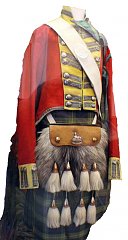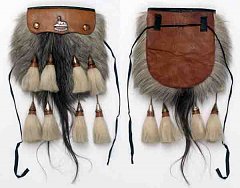|
-
16th March 21, 10:26 AM
#1
 Originally Posted by Jacques

i guess my interest lies with when the Highland regiments stopped using the great kilt, the +/- 8 yard double width plaid and began exclusively wearing the kilt which appears much as todays modern kilts.
Broadly speaking, c1800. Here's Ensign Bramwell's 92nd uniform made in 1815: sewn 4 yard box pleated kilt with half plaid.

Last edited by figheadair; 16th March 21 at 10:29 AM.
-
The Following User Says 'Aye' to figheadair For This Useful Post:
-
16th March 21, 10:37 AM
#2
 Originally Posted by figheadair

Thank you Peter.
So there's my missing link i suppose. Great kilt, Kilt with half plaid, and a little kilt of sorts; closer to its modern cousin. i wonder what Sgt Anton was on about.
Last edited by Jacques; 16th March 21 at 10:47 AM.
Reason: additional comment
"I know of no inspiration to be got from trousers."
Lt. Col. Norman MacLeod, QOCH, c. 1924
-
-
16th March 21, 10:49 AM
#3
 Originally Posted by figheadair

That is one massive and impressive sporran. More in there, I'd wager, than his handkerchief.
Rev'd Father Bill White: Mostly retired Parish Priest & former Elementary Headmaster. Lover of God, dogs, most people, joy, tradition, humour & clarity. Legion Padre, theologian, teacher, philosopher, linguist, encourager of hearts & souls & a firm believer in dignity, decency, & duty. A proud Canadian Sinclair with solid Welsh and other heritage.
-
The Following 3 Users say 'Aye' to Father Bill For This Useful Post:
-
16th March 21, 11:23 AM
#4
 Originally Posted by Father Bill

That is one massive and impressive sporran. More in there, I'd wager, than his handkerchief.
Actually, it was all about show; form rather than function. The bag itself is relatively modest.

-
The Following 2 Users say 'Aye' to figheadair For This Useful Post:
-
16th March 21, 12:41 PM
#5
 Originally Posted by figheadair

Actually, it was all about show; form rather than function. The bag itself is relatively modest.

I rather thought as much, but much appreciated for the photographic evidence, Peter!
Rev'd Father Bill White: Mostly retired Parish Priest & former Elementary Headmaster. Lover of God, dogs, most people, joy, tradition, humour & clarity. Legion Padre, theologian, teacher, philosopher, linguist, encourager of hearts & souls & a firm believer in dignity, decency, & duty. A proud Canadian Sinclair with solid Welsh and other heritage.
-
The Following User Says 'Aye' to Father Bill For This Useful Post:
-
17th March 21, 10:33 AM
#6
I tend to remember the difference this way:
-Feileadh Beag is smaller, so you're 'begging' for more cloth. Therefore, single width.
-Feileadh Mor has 'more' cloth to begin with. Therefore, double width.
And to my knowledge, the Feileadh of the period would typically only have maybe 4 yards of material, whether single or double width. The 'whole 8 yards' kilts didn't really come into use until the latter Victorian era (1880s-90s). And the same for pleating to the sett; most were to the stripe or so roughly pleated as to have no pattern to the pleats, until that latter period. Soldiers would have been issued at most 4 yards of fabric annually, which was made into the kilt. Apparently those with sewn pleats picked them apart quarterly, hunted any cooties, turned the fabric, resewn on the fresh edge (to combat wear) and repeated on the opposite face in three months.
If this is an out of date understanding, I welcome any corrections.
-
The Following User Says 'Aye' to KnittedReenactor For This Useful Post:
-
23rd March 21, 07:56 AM
#7
Beag and mor are merely Gaelic for little and big, keeping that in mind helps.
The "philebeg" is mentioned in the 1746 proscription.
And there's the story about Rawlinson inventing it around 1730.
Seems that the philabeg was worn in the 18th century Highland regiments for fatigues etc.
Barnes says that the philamore was only worn by officers after 1794, Other Ranks having a small plaid (belted plaid or fly plaid, a decorative garment) to wear with the philabeg in Full Dress.
Not long after the officers followed suit.
What people sometimes forget is that on campaign and in action officers would be mounted, wearing riding breeches and Hessian boots. Generally officers were only kilted on parade with the regiment, or in Levee Dress.

Last edited by OC Richard; 23rd March 21 at 07:58 AM.
Proud Mountaineer from the Highlands of West Virginia; son of the Revolution and Civil War; first Europeans on the Guyandotte
-
The Following User Says 'Aye' to OC Richard For This Useful Post:
 Posting Permissions
Posting Permissions
- You may not post new threads
- You may not post replies
- You may not post attachments
- You may not edit your posts
-
Forum Rules
|
|

Bookmarks